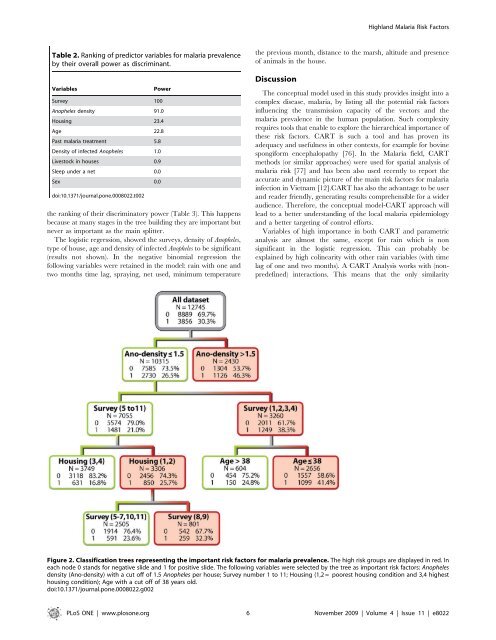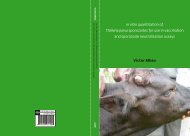Ranking malaria risk factors to guide malaria cont... - ResearchGate
Ranking malaria risk factors to guide malaria cont... - ResearchGate
Ranking malaria risk factors to guide malaria cont... - ResearchGate
Create successful ePaper yourself
Turn your PDF publications into a flip-book with our unique Google optimized e-Paper software.
Highland Malaria Risk Fac<strong>to</strong>rs<br />
Table 2. <strong>Ranking</strong> of predic<strong>to</strong>r variables for <strong>malaria</strong> prevalence<br />
by their overall power as discriminant.<br />
Variables<br />
Power<br />
Survey 100<br />
Anopheles density 91.0<br />
Housing 23.4<br />
Age 22.8<br />
Past <strong>malaria</strong> treatment 5.8<br />
Density of infected Anopheles 1.0<br />
Lives<strong>to</strong>ck in houses 0.9<br />
Sleep under a net 0.0<br />
Sex 0.0<br />
doi:10.1371/journal.pone.0008022.t002<br />
the ranking of their discrimina<strong>to</strong>ry power (Table 3). This happens<br />
because at many stages in the tree building they are important but<br />
never as important as the main splitter.<br />
The logistic regression, showed the surveys, density of Anopheles,<br />
type of house, age and density of infected Anopheles <strong>to</strong> be significant<br />
(results not shown). In the negative binomial regression the<br />
following variables were retained in the model: rain with one and<br />
two months time lag, spraying, net used, minimum temperature<br />
the previous month, distance <strong>to</strong> the marsh, altitude and presence<br />
of animals in the house.<br />
Discussion<br />
The conceptual model used in this study provides insight in<strong>to</strong> a<br />
complex disease, <strong>malaria</strong>, by listing all the potential <strong>risk</strong> <strong>fac<strong>to</strong>rs</strong><br />
influencing the transmission capacity of the vec<strong>to</strong>rs and the<br />
<strong>malaria</strong> prevalence in the human population. Such complexity<br />
requires <strong>to</strong>ols that enable <strong>to</strong> explore the hierarchical importance of<br />
these <strong>risk</strong> <strong>fac<strong>to</strong>rs</strong>. CART is such a <strong>to</strong>ol and has proven its<br />
adequacy and usefulness in other <strong>cont</strong>exts, for example for bovine<br />
spongiform encephalopathy [76]. In the Malaria field, CART<br />
methods (or similar approaches) were used for spatial analysis of<br />
<strong>malaria</strong> <strong>risk</strong> [77] and has been also used recently <strong>to</strong> report the<br />
accurate and dynamic picture of the main <strong>risk</strong> <strong>fac<strong>to</strong>rs</strong> for <strong>malaria</strong><br />
infection in Vietnam [12].CART has also the advantage <strong>to</strong> be user<br />
and reader friendly, generating results comprehensible for a wider<br />
audience. Therefore, the conceptual model-CART approach will<br />
lead <strong>to</strong> a better understanding of the local <strong>malaria</strong> epidemiology<br />
and a better targeting of <strong>cont</strong>rol efforts.<br />
Variables of high importance in both CART and parametric<br />
analysis are almost the same, except for rain which is non<br />
significant in the logistic regression. This can probably be<br />
explained by high colinearity with other rain variables (with time<br />
lag of one and two months). A CART Analysis works with (nonpredefined)<br />
interactions. This means that the only similarity<br />
Figure 2. Classification trees representing the important <strong>risk</strong> <strong>fac<strong>to</strong>rs</strong> for <strong>malaria</strong> prevalence. The high <strong>risk</strong> groups are displayed in red. In<br />
each node 0 stands for negative slide and 1 for positive slide. The following variables were selected by the tree as important <strong>risk</strong> <strong>fac<strong>to</strong>rs</strong>: Anopheles<br />
density (Ano-density) with a cut off of 1.5 Anopheles per house; Survey number 1 <strong>to</strong> 11; Housing (1,2 = poorest housing condition and 3,4 highest<br />
housing condition); Age with a cut off of 38 years old.<br />
doi:10.1371/journal.pone.0008022.g002<br />
PLoS ONE | www.plosone.org 6 November 2009 | Volume 4 | Issue 11 | e8022











